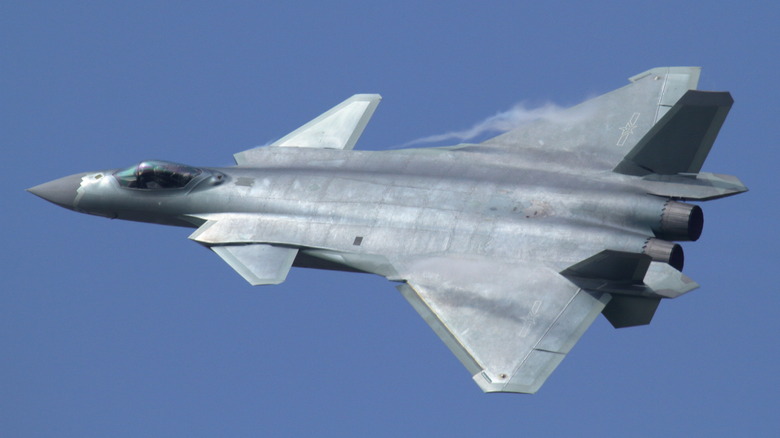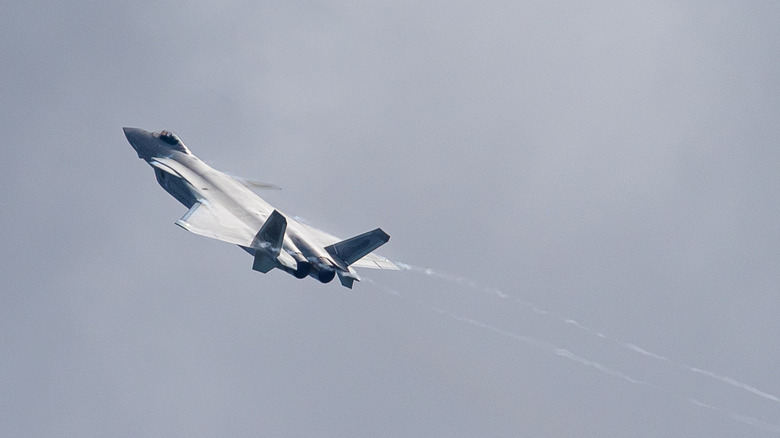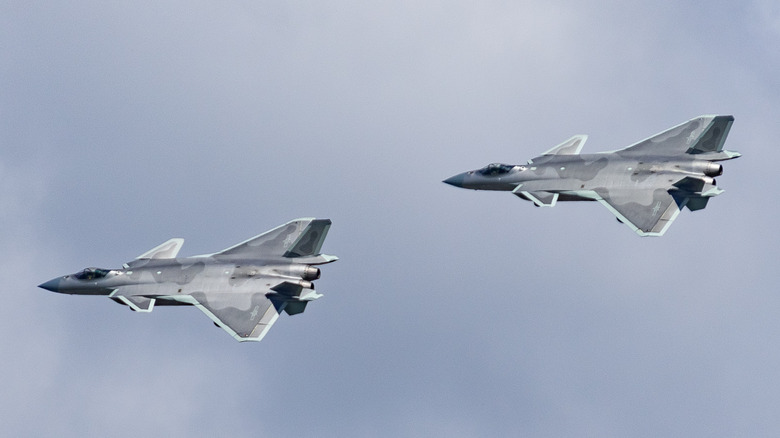J-20 Top Speed: How Fast Is China's Jet Compared To The F-22 Raptor?
In recent years, China has made remarkable strides in military aviation, developing some of its most advanced fighter jets to date, such as the Chengdu J-10C "Vigorous Dragon," the JF-17 "Thunder," and the Shenyang J-11 and J-15, which are reverse-engineered derivatives of the Russian Su-27. Sitting at the top of China's fighter jet food chain is the Chengdu J-20, nicknamed the "Mighty Dragon." It is often described as China's crown jewel, the Mighty Dragon, which is touted as a fifth-generation air superiority stealth fighter designed to rival the most sophisticated jets from the West.
While the J-20 has never seen real combat, China has made bold claims about its capabilities. The earlier variants of J-20 were powered by a pair of Saturn AL-31FM2 afterburning turbofan engines, each producing 32,000 pounds of thrust, with the fighter jet reaching Mach 2.55. However, newer versions of the J-20 have shifted to homegrown Shenyang WS-10B engines, each producing around 30,000 pounds of thrust.
It is a twin-engine, all-weather stealth fighter with serious potential. Its design clearly borrows heavily from the F-22 Raptor and the YF-23, with many critics calling it a copycat. But is the J-20 merely a lookalike, or does it pose a legitimate challenge to Western air dominance?
J-20's top speed, climb rate, and range
Precise specifications on Chinese aircraft are hard to confirm, as Chinese forces operate in secrecy. Still, according to Airforce Technology, the J-20 can reach a maximum speed of 1,304 miles per hour (roughly around Mach 1.7), while some estimates push that figure up to 1,534 miles per hour or Mach 2. Meanwhile, the climb rate is believed to be around 60,000 feet per minute. Its combat radius is estimated between 745 and 1,367 miles. Its service ceiling tops out at 60,000 feet and can carry up to six missiles within its internal weapons bay, essential for maintaining stealth without sacrificing firepower.
The F-22 shares the same twin-engine layout with stealth-centric philosophy. In terms of speed, the F-22 can cruise at Mach 1.82 (around 1,396 miles per hour) without afterburners and reach a top speed of Mach 2.25 (roughly 1,726 miles per hour) when pushed to its limits. Official records list Raptor's service ceiling at 50,000 feet, though some sources suggest closer to 65,000 feet.
The Raptor is powered by two Pratt & Whitney F119-PW-100 turbofan engines, each producing 35,000 pounds of thrust, and is equipped with two-dimensional thrust-vectoring nozzles. Its combat radius is limited compared to the J-20's, ranging from 529 to 679 miles depending on mission profile; however, the U.S. Air Force's extensive aerial refueling network greatly extends its operational range. It can also carry two more weapons than the J-20 in its internal weapons bay, for a total of eight missiles.
Fifth-gen showdown: J-20 and its global competition
Currently, China is the only country outside the U.S. with its own fully operational fifth-generation stealth fighter in meaningful numbers. Russia's Sukhoi Su-57 is often brought into the stealth conversation but remains limited in production and deployment, with 44 Su-57 in service as of April 2025. That makes the J-20 the only real global stealth counterpart to the F-22 and the F-35. Experts generally consider the F-22 superior to the J-20 in raw performance, especially regarding stealth capability, as it's considered one of the most stealthy jets ever produced. Some analysts have pointed out that design features like the J-20's canards and delta wing layout may improve maneuverability but could compromise its stealth profile.
Chengdu's J-20 is a work in progress but continues being improved. Most recent upgrades have enhanced its radar systems, reportedly increasing its detection range by three times, and bringing it closer to Western radar technology. Moreover, its biggest limitation, the current WS10 engine, is being addressed. China is developing the new WS-15 engine, which promises better efficiency and may enable the J-20 to achieve true supercruise and thrust vectoring capabilities just like the F-22.
The J-20 may have started off as a heavily inspired platform, but it's slowly becoming a true fifth-generation fighter. While not yet at the level of the F-22 in key performance metrics, its long range, evolving tech, and rapid upgrades make it a serious contender in modern air combat. Whether it's a match for America's air dominance remains to be seen, but it's no longer fair to call the J-20 just a knockoff.


